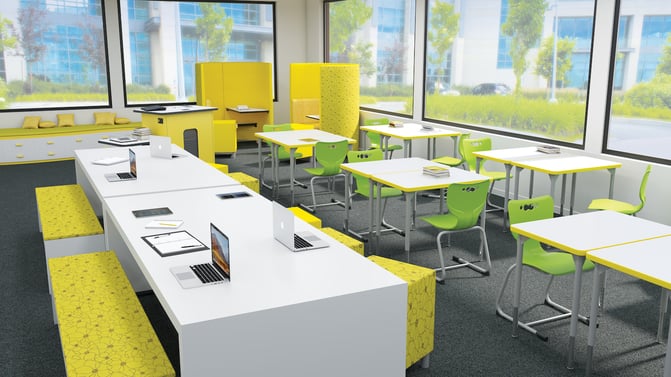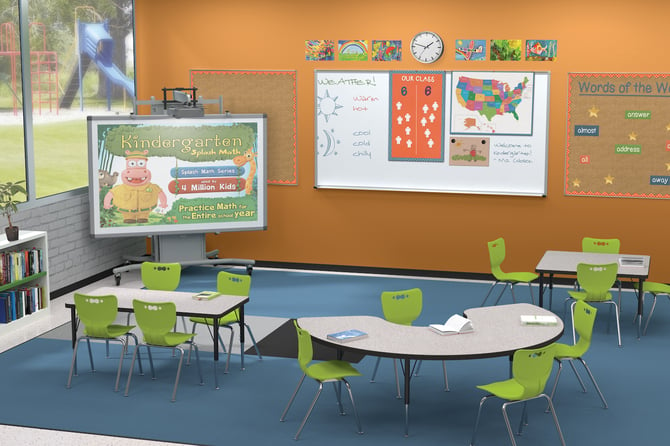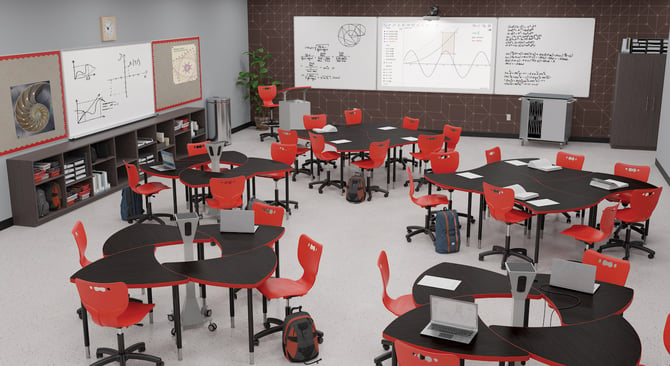5 Colors In The Classroom That Will Boost Active Learning
Posted by MooreCo Inc on Dec 27, 2019 12:30:00 PM
5 Colors In The Classroom That Will Boost Active Learning
Colors in the classroom environment have been proven to maximize information retention, stimulate participation, and boost active learning. But what colors are the best to achieve these results for active learning? The key to creating an environment conducive to student learning in a classroom is to put learners at ease, avoiding overstimulation.
Color can affect our feelings, memory, attention and motivation to work due to their impact on our emotions. Anything from wall color to accent items like chairs, desks or tables, might have a unique outcome on the classroom atmosphere. Here are 5 color combos in the classroom that you should consider to promote student learning.

Color - bright colors in particular - stimulate the brain and help boost memory. In the past, color was primarily used as a tool to influence early learners. Recently, it has been shown that this effect carries across all age groups.
According to the College of St. Scholastica, “color does indeed have an impact on student behavior, academic performance, and feelings of well-being”. In addition to their overall influence, color theory indicates that each color has specific traits that impact students in different ways. For example, greens and blues are often seen as calming, while eye-catching reds and oranges are more invigorating.
Let’s take a look at how color works and how you can incorporate color into your classroom to encourage learning and improve the mood of your students.
1) Red: The Energizer
Red stimulates the adrenal glands and can generate feelings of energy and encourage creativity conducive to active learning. In your classroom, try using the color red in conjunction with repetitive or detailed oriented tasks. This will give students an energy boost.
2) Yellow: The Attention Grabber
When it comes to grabbing and maintaining the attention of your students, yellow is king. Yellow generates positive energy, encourages creativity and is the ultimate tool in capturing the attention of a restless classroom. Display important study materials on yellow glass boards. Add splashes of the color throughout your room, such as soft seating or student chairs, to promote alertness.

3) Orange: The Mood Lifter
The color orange encourages critical thinking and memory. Studies have shown that orange has a particularly high effect on circulation and the nervous system. It increases the oxygen supply to the brain, stimulating mental activity and loosening inhibitions. Be sure to bring snacks though, because it’s also been known to increase appetite!

4) Green: The Calming Concentration Catcher
Green promotes calmness and a sense of relaxation and is great for encouraging long-term concentration and mental health. It is the most restful color for the eye and creates a feeling of ease when used in a classroom. Use large blocks of this color, like soft seating or a coordinated set of makerspace furniture, to spread a calming atmosphere throughout your class.

5) Blue: The Productivity Driver
The color blue has proved to have a calming effect on the heart rate and respiratory system of students. It encourages a sense of well-being, making it ideal for learning situations that are intensely challenging and cognitively taxing.
Research suggests that people with highly intellectual work that requires a high cognitive load are most productive in blue environments. Adding touches of blue to the edges of tables and student desks can create a calming atmosphere that encourages productivity and creative thinking, regardless of the subject.
Don't be afraid to branch out and try different color combinations! If you have any questions about the best way to incorporate paint color into your classrooms, please reach out to us.
Topics: Color, Active Learning, Educators


